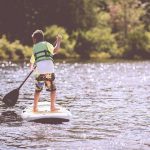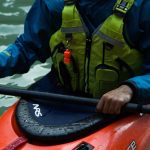You can have a lot of fun and relax by stand-up paddleboarding. You don’t need many things to do it and you can paddle in the ocean, lake, or river–with no waves necessary.
Choose a board based on weight, volume, capacity, and size.
Types of SUP Boards
Paddleboards are available in two main types: an all-around planning hull and a touring / racing displacement hull. The advantage of these boards is that many are suitable for several types of paddling.
All Arounders
Vehicles that have a traditional surfboard-style hull and are 10′ to 11’6′ long, and 29″ to 33″ wide are best for beginners, anyone who paddles on a calm lake and stays close to shore, or those who want to fish from their boards.
Race, Touring, and Downwind SUPs
Touring and race boards typically have a pointed nose or bow, which is more efficient and requires less effort to paddle longer distances. Most boards are 12’6″ or 14′ long. When choosing a board, make sure to pick one that is stable for you. Narrower boards tend to be more unstable.
Kids’ SUPs
There are different types of boards that children can use, depending on the situation. All-arounder boards that are shorter (about 9’0″) are much easier for children to carry and maneuver than boards made for adults.
Children’s boards are narrower, similar to their shoulders, so when they paddle, they paddle directly down next to the rail. Another important thing to consider for children is their paddle.
Kids’ paddles are designed specifically for smaller paddlers, with a smaller shaft and blade.
Family Board
This paddle board is easy to use and perfect for entertaining the whole family. Its longboard style and wide planning nose make it ideal for beginners, while its stable squash tail ensures hours of fun for everyone.
Boards for Women
/**/ Some SUP boards are designed to be easier to carry and remove from the top of a car, with features such as a narrow middle section to help reach the deck handle and the opposite side of the board.
Weight and Carry Handle
Make sure to research the weight of a paddle board before purchasing one. Most paddle boards weigh 20-30 pounds.
The new butterfly handle with a comfortable grip is much better than the old carrying handles. The old handles make it very difficult to pick up and carry your board.
The new handles make it very easy to carry your board.
Balance and Board Width
The Wider the board, the more stable it will be. Board width is the most important factor in determining stability. SUP boards are made up to 33″ wide to accommodate a variety of body types.
The wider the board, the more stable it will be.
A wider board also provides more stability and resistance to tipping, crucial when you’re paddling in waves or currents. Boards that are 31 inches wide or wider are ideal for larger people or anyone with poor flexibility or recent leg or hip injuries.
The added width and thickness help displace your weight in the water, providing more stability and resistance to tipping.
Smaller paddlers who weigh up to 190 pounds should consider a narrower board. Narrower boards are more maneuverable and lighter to carry than larger boards.
Board Length
The first thing you need to consider when choosing a SUP board is whether it will displace the correct amount of water for your weight.
You also need to think about how long the board is in relation to your car and how you’ll be storing it. Longer boards are harder to carry, especially if you have to walk a long way to get to the water.
Average Size Surf Style Paddle Boards (10′ to 11’6′)
If you’re just starting out or are looking for a leisurely activity with no specific goal, you’ll be satisfied with a shorter board.
Those with more experience need a shorter board for more mobility.
Touring & Racing Displacement Paddle Boards (12.6′ or 14′)
If you want to race or tour, you’ll need a longer board, which will make you faster than if you had a short board.
Fins
There are four variations of fins that add tracking and stability to a paddleboard.
Large Single Fin
This text is discussing how to adjust the fin on a paddleboard. The fin is placed in a box at the back of the board, and can be moved forwards or backwards.
Pushing it towards the back of the board makes it track better in a straight line, which is better for racing or touring. Pushing it forwards towards the nose makes it turn easier, which is better for surfing or paddling in whitewater.
3-Fin Setup
A thruster is a surfboard with three fins, one in the center and two on the sides. This setup is also known to work well for tracking on flatwater.
If you remove the center fin, the two side fins, called “side bites,” will still work for tracking on flatwater or in surfing.
Race Fins
There are several different types of fins available, each with its own advantages and disadvantages. Some fins are rigid and inflexible, which makes them ideal for downwind runs on larger boards.
However, these fins are more likely to break if they hit something hard, like a rock. Other fins are more flexible, which makes them less effective for performance but more likely to bounce off of obstacles without breaking.
Inflatable SUP Fins
either flexible rubber fins or detachable semi-rigid fins can be attached to the board
Board Construction
The most common material for boards is EPS foam wrapped with fiberglass, carbon fiber, or plastic.
Boards can be hollow or solid. Most rotomolded boards are hollow, but they are very heavy. Some high-end boards may be hollow to save weight and increase performance.
Plastic (Rotomolded)
The exterior of these boards is very durable, making them a great option for rental companies. They are also affordably priced and quite heavy, which is ideal for going down rivers and rapids.
Fiberglass and Epoxy Over EPS Foam
This type of board is in the mid-range price and can be used for many types of paddling. It is the most common board type. Construction techniques vary with these boards, so weights vary widely, too.
Some boards have a sheet of wood under the fiberglass deck to add durability and stiffness; others use an infused epoxy process that makes the board’s exterior extra tough.
Inflatables
This kayak is very durable and light to carry. It can be used for a variety of paddling, from whitewater to slow speed.
It is made of PVC with drop-stitch construction, and it is easily stored in apartments, the overhead compartments of planes, or in the back of your car.
Softtops
These paddle boards feature user-friendly designs that are fun for the whole family. With a hard bottom cover and ultra-high density EVA rails, these boards are impact resistant, so you can walk to both ends of the board or bring your dog with you.
The soft top paddle boards are worry-free.
What Size SUP Board Is Right for You?
When choosing a paddle board, you should consider how much flotation and stability you will need based on your skill level and body weight. You should also pick a board that is the right size and shape for the type of paddling you want to do.
The most popular SUP boards for general use are 10-11 feet long and 33-34 inches wide. Wider boards are less stable and less fun to paddle.
If portability and maneuverability are two things you are looking for, you may want to go with a board that is shorter than average. 9’6″ boards can be just as much fun and just as stable if the design is right.
Just make sure that the width is appropriate for the length, which is about 30-32 inches. A 9’6″ board that is wider than 32 inches will not paddle as quickly.
A 12’6” touring or race board is a good choice if you prioritize speed and straight tracking. 32 inches is a good width for a stable touring board, but race boards can be 28” or even 26” narrow, which makes them very fast but less stable. 30” is a common compromise width for a 12’6” board that may be used for both touring and racing.
Given the popularity of SUP touring, 12’6” should be a very popular length, but some buyers shy away from this length due to storage concerns.
However, if you go with an inflatable model, the extra length does not pose a storage issue and you can expect excellent performance from a quality inflatable touring SUP.
There are also specialized shapes for specific uses. For example, 36-inch wide boards are commonly used for running rapids but are too wide for general paddling as they are slow and you have to reach over more to keep your stroke vertical.
In contrast, boards under 9 feet in length are usually designed for ocean or river surfing, but the lack of volume on these boards makes it harder to stay balanced for general paddling.
Hard paddle boards may be better for racing and surfing performance, however, inflatable boards are more stable due to their uniform thickness.
The thickness of a paddle board is just as important as its length, width, and shape. Paddle boards that are 5 inches thick are generally best for all-around paddling and for people who are still developing their skills.
However, heavier paddlers (225 lbs and up) may benefit from the extra volume of a 6-inch thick board, even though it is bulkier and has other disadvantages.
Don’t buy a board without first understanding the wide range of available inflatable SUP board shapes, constructions, and fin systems.
The best way to gain this understanding is to spend some time studying a comprehensive and technically advanced inflatable SUP product line.
The recommendation of a 5-inch thickness for most of the weight ranges comes with a condition: Just like with smartphones and laptops, making a thinner product with excellent strength and rigidity requires better materials and construction methods, which is likely to cost a bit more than a thicker product made from cheaper materials.
The proportions that are recommended for a paddle board can differ a lot depending on what the board is going to be used for.
If you are a more experienced paddler and want a board that can be used for different things like cruising on flat water, surfing, and moderate distance touring, then here is a general guide for you.
When you are choosing a SUP board, it is important to consider what performance characteristics you want.Advanced riders usually choose boards based on this more than size or weight.
Use this chart as a starting point to find a board that will still be a good fit for you as you improve your skills.
You may notice that length recommendations do not vary much between the beginning and advanced paddlers.
This is because, while the length is a key element in the performance and intended use of a paddle board, it is less directly related to rider weight and is more affected by other factors such as those below:
- Paddler height and relative reach
- How do you intend to use the board
- The range of water and wind conditions you expect to encounter
- Who else might be using your board
- Your likelihood of having passengers on board (small children and pets)
Before you purchase an inflatable SUP, it is important to know the range of length, width, and thickness you are looking for. However, there are several other factors you will want to consider before making a final decision.
Next Steps in Choosing A Paddle Board
The best way to find the perfect paddle board is to start by looking at the best all-around inflatable paddle board page. This will give you an idea of what size paddle board you should be looking for and what is most popular with paddlers who want to get out and have a great time on the water.



